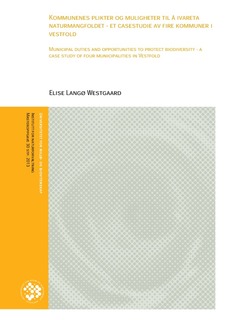| dc.description.abstract | Lovverket knyttet til naturverdier og arealforvaltning har endret seg mye gjennom tiden. I dag er det blant annet naturmangfoldloven (NML) og plan- og bygningsloven (PBL) som skal
sikre naturverdier og at arealene forvaltes på en bærekraftig måte. I lovene følger det en rekke
plikter og muligheter som vil være viktig for å ivareta naturmangfoldet i planleggingen. Den
største trusselen mot naturmangfoldet er arealbruk. I Norge er det er i stor grad kommunene
som styrer arealbruken gjennom arealplanlegging. Jeg har derfor valgt fire casekommuner
(Sandefjord, Nøtterøy, Tønsberg og Larvik) i Vestfold med høyt utbyggingspress, for å
undersøke hvordan kommunene ivaretar naturmangfoldet i saksbehandlingen av planer
behandlet etter PBL. For å belyse denne problemstillingen valgte jeg å utføre kvalitative
forskningsintervjuer i kommunene, med en på forhånd utarbeidet intervjuguide. De mest
sentrale resultatene fra intervjuet er at PBLs bestemmelser, som kan være viktige for å ivareta
naturmangfoldet, i noen grad tas inn i planene i kommunene som overordnede retningslinjer,
dette gjelder særlig ”bærekraftig utvikling”. Ellers inkluderer kommunene naturhensyn i
planbeskrivelser og konsekvensutredninger. Kommunene har videre i begrenset grad benyttet
seg av de mulighetene PBL gir når det gjelder å ivareta naturmangfoldet. De har blant annet
arealformålene landbruks-, natur- og friluftsformål og grønnstruktur i kommuneplanens arealdel. Mens det kun er Larvik av kommunene som har hensynssoner som er viktige for naturmangfoldet. Samtidig har ingen av kommunene planbestemmelser som sikter på å ivareta naturmangfoldet. Når det gjelder den generelle betydningen av NML for planleggingen var det enighet i kommunene om at loven har ført til mer fokus på naturmangfoldet, og har endret saksbehandlingen av planene ved at NML §§ 8-12 skal inngå i beslutningsgrunnlaget. Videre forsto jeg informantene slik at det er gjennomførbart å ivareta bestemmelsene i naturmangfoldlovens kapittel II om alminnelige bestemmelser om
bærekraftig bruk, men at det var litt usikkerhet om hvordan NML §§ 8-12 skulle drøftes og vektlegges i planleggingen. Det har også vært en utfordring å bygge opp kunnskap om naturmangfoldloven, og å avgjøre hvor mye som skal vurderes i den enkelte sak. Kommunene prioriterer naturmangfoldet forskjellig. Hensynet til naturmangfoldet blir for eksempel høyt prioritert i Larvik kommune, mens i Nøtterøy kommune prioriterer de ikke naturmangfoldet mer enn loven pålegger kommunen. Grunnlaget for hvordan hensynet til naturmangfoldet blir vektlagt i planleggingen og egeninteressen av å ta vare på naturen, vil variere og påvirkes av flere faktorer, som blant annet faglig bakgrunn. Laws relating to natural resources and land management have changed a lot over time. Today it is the Nature Conservation Act (NCA) and the Planning and Building Act (PBA) that secure
natural resources and areas that are managed in a sustainable manner. The legislation follows
a number of duties and opportunities that will be important to protect biodiversity in the
planning. The greatest threat to biodiversity is use of land. In Norway it is mainly the
municipalities that control the use of land through planning. I have therefore chosen four case
municipalities (Sandefjord, Nøtterøy, Tønsberg and Larvik) in Vestfold with high
development pressure, in order to examine how municipalities protect biodiversity in the
proceedings of plans processed by PBA. To illustrate this issue, I decided to conduct
qualitative research interviews in municipalities, with a pre-prepared interview guide. The
most important results of the interview is that PBA’s provisions, that may be important to
protect biodiversity, only in some extend are included in the plans of municipalities as general
guidelines, especially "sustainable development". In other cases the municipalities include
nature conservation by use of the plan review and environmental impact assessment.
Furthermore, the municipalities have in limited extend taken advantage of the opportunities
PBA provides when it comes to protect biodiversity. They include agricultural, natural and
recreational purposes regarding use of land and green areas, in the municipal area plan.
Larvik is, however, the only municipality which has regard zones that are important for
biodiversity. Meanwhile, none of the municipalities have any plan provisions that aim to
protect biodiversity. When it comes to the overall signification of the NCA for the planning, it
was agreed that the law has led to more focus on biodiversity, and has changed the
proceedings of the plans by including the NCA §§ 8-12 in the decision-making. Furthermore,
the informants gave me the impression that it is feasible to safeguard biodiversity provisions
of Chapter II relating to general provisions on sustainable use, but it was a little uncertainty
regarding how NCA §§ 8-12 were to be discussed and emphasised during planning. It has also
been a challenge to build up knowledge about NCA, and to determine the amount to be
assessed in each case. The municipalities prioritize biodiversity differently. The consideration
of biodiversity has a high priority in Larvik municipality, while in Nøtterøy they don’t
prioritize biodiversity more than the law requires of the municipality. The basis of how the
interests of biodiversity will be emphasized in planning and the self-interest to preserve
nature, will vary and are influenced by several factors, as for example academic background. | no_NO |
